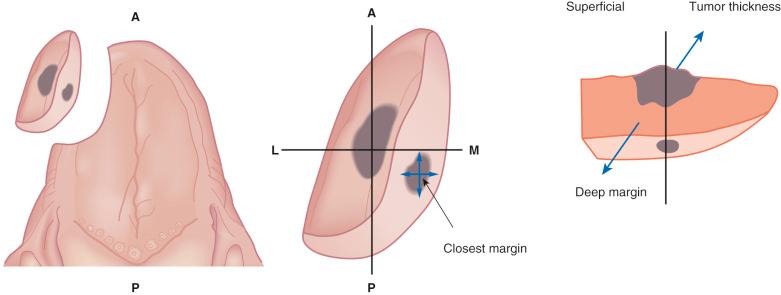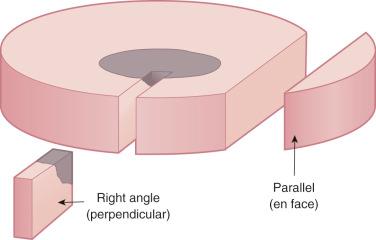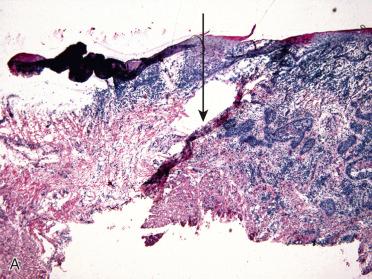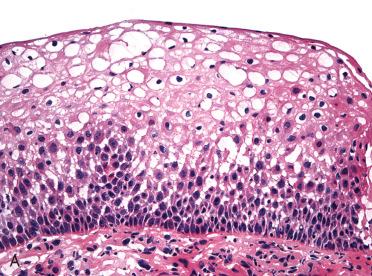Physical Address
304 North Cardinal St.
Dorchester Center, MA 02124
Intraoperative consultative diagnosis on mucosal lesions may be performed in the setting of an untreated primary mucosal lesion or in the setting of a recurrent/persistent lesion after prior treatment (i.e., radiation and/or chemotherapy):
In general, intraoperative consultation should not be requested to render a primary diagnosis of a mucosal lesion.
Rather routinely processed biopsy material is preferred mechanism for rendering a definitive diagnosis in individuals with primary mucosal lesion
After biopsy diagnosis many head and neck mucosal carcinomas receive primary nonsurgical adjuvant therapy so that intraoperative consultation is not uncommon in a setting of a post-therapeutic recurrent or persistent mucosal lesion.
Indications for intraoperative consultation of mucosal lesions of upper aerodigestive tract include:
Render a histologic diagnosis (e.g., carcinoma/dysplasia) to ensure adequacy when definitive therapeutic intervention is planned immediately.
Assessment of adequacy of resection (i.e., surgical resection margins)
Preliminary assessment of nature of a planned procedure based on the extent and distribution of the neoplasm (e.g., subtotal versus total resection)
Adequacy for diagnostic purposes
Determination for special handling (e.g., immunohistochemistry, flow cytometry, microbiologic cultures, other)
Determination of neurotropism, lymph-vascular space invasion (LVI), or bone involvement that may necessitate resection of the involved bone (e.g., mandibulectomy)
If lymph nodes are excised, then a frozen section may be requested to exclude the presence of metastatic disease and the need for a neck dissection.
Establish the diagnosis of carcinoma/dysplasia and differentiate it from lookalike lesions.
Confirm presence or absence of lesional tissue at the margins of resection.
When applicable, identify the presence of osseous involvement.
When applicable, identify the presence of nodal metastasis.
Evaluation of surgical margins of resection for the presence or absence of lesional tissue falls under the purview of the surgical pathologists; however, how the specimen is removed and the orientation of the specimen ( Figs. 7-1 and 7-2 ) are the responsibility of the surgeon:
Particularly true for those cases in which the tumor is initially excised and the designated margins are separately removed, the tumor is removed in multiple parts or the specimen is a complex en bloc excision, requiring proper orientation by the surgeon for those margins that are of critical concern.


Once removed and properly oriented, the specimen becomes the responsibility of the surgical pathologist.
There is no standard method by which surgeons remove tissue and thereby request intraoperative consultation of the surgical resection margins; some approaches include:
Excision of the entire lesion, designation of specific margins, and tissue selection by the pathologist for frozen section
Circumferential resection margins are submitted for frozen section irrespective of the number of frozen sections that may be required to completely evaluate the circumferential margins.
A limited number of frozen sections (e.g., up to four—anterior, posterior, medial, and lateral) are submitted as determined by the pathologist.
NOTE: Anatomy of the head and neck is complex and in any given resection the risk posed by removing the entire lesion and surrounding structures for intraoperative consultation includes:
Loss of the three-dimensional orientation of the specimen
Erroneous sampling of the areas of concern
Submission of biopsies from areas of clinical concern after the main resection, and these biopsies are entirely submitted for frozen section.
Right angle section advantages include:
Technically easier to obtain full thickness sections
Distance of the lesion to the resection margin can be viewed and measured.
Right angle section disadvantages include:
Allows for evaluation of a relatively small area of the lesion/margin
Parallel section advantages include:
Allows for evaluation of a larger area of the lesion/margin to include an entire margin if necessary
Parallel section disadvantages include:
If the surgical margin is uninvolved, the distance of the lesion to the resection margin cannot be viewed and/or measured.
Due to retraction from the underlying connective tissues the superficial layers (i.e., mucosa and submucosa) may not be optimally seen.
NOTE: If parallel sections are made, the recommendation is to embed the tissue with the true surgical margin deepest in the block.
Diagnostic accuracy for oral tongue cancer should be the same whether the sample was taken from the patient or from the surgical specimen.
Arguably, the most common request of the pathologist by the head and neck surgeon at the time of intraoperative consultation is assessment of the surgical margins.
Successful local control of a malignant tumor depends on complete surgical excision of all the disease.
Presence of gross residual cancer results in local persistence of disease and increased morbidity and mortality.
There are many factors that affect the assessment of the surgical margins, including the type of surgical specimen, proper orientation of the specimen, proper sectioning of the specimen, and obviously the correct interpretation of the histopathologic changes.
Unfortunately, even in the best situations an intraoperative report of negative margins may be followed a few days later by a permanent section diagnosis of positive margins.
Probability of local recurrence in head and neck cancer is reduced when the resection margins are determined by intraoperative frozen section consultation.
Use of intraoperative frozen sections allows the surgeon to extend the surgical resection without loss of orientation of the operative field, a potential problem when additional surgery is required in a second operation.
Carcinoma remnants that have not been completely removed in the initial operation often are difficult to identify macroscopically, making their removal in a second operation more difficult.
Although the frozen section diagnosis of surgical margins is extremely accurate, it is not entirely reliable in eliminating positive margins in the final diagnostic report.
Specimens in which no tumor or dysplasia is present at the surgical margins of resection are considered completely excised.
“At the margin of resection” means that the neoplastic cells are seen in contact with or lie within millimeters of the pigment that was painted along the margin prior to sectioning (i.e., tumor across or up to the resection margin):
In this situation, the specimen is considered incompletely excised, requiring a wider excision to be assured that all viable tumor cells have been adequately removed.
Sole reliance of margins as assessed on the resected specimen should be discouraged and, when feasible, the intraoperative evaluation of tissue surrounding the specimen should be made and regarded as the “true margin.”
Histologic definition of what constitutes a “positive” margin should be uniformly accepted and applied:
Discrepancy in the literature as to what constitutes a positive or negative resection margin
Some authorities only include invasive carcinoma at the margin as positive, excluding carcinoma in situ, dysplasia, and gross residual disease.
Most pathologists would agree with the classification of positive margins as defined by:
Presence of lesional tissue within 0.5 mm of the surgical margin (so-called close margins) with the exception of laryngeal lesions (see later)
Significant dysplastic epithelium at the margin (see later)
Carcinoma in situ at the margin
Invasive carcinoma at the margin

Evaluation of dysplasia under optimal circumstances (i.e., permanent sections) can be subjective, let alone at the time of frozen section, where tissue distortion and artifact create additional diagnostic difficulties potentially resulting in misdiagnoses, including overdiagnosis and underdiagnosis.
In the upper aerodigestive tract (UADT), especially the oral cavity and larynx, the most common type of intraepithelial dysplasia is keratinizing dysplasia:
See Section 5, Larynx, for a discussion on keratinizing severe dysplasia.
In brief, keratinizing moderate dysplasia and keratinizing severe dysplasia share a similar statistical risk of progression to invasive carcinoma.
Therapeutic approach is similar for keratinizing moderate and severe dysplasia.
For all intents and purposes, keratinizing severe dysplasia is synonymous with carcinoma in situ.
Progression of keratinizing mild dysplasia to higher grade epithelial lesions is so low as to make this diagnosis of little clinical significance and often of minimal concern to head and neck surgeons.
Given the previous statements, a two-tiered classification system can be advocated for keratinizing dysplastic lesions of the UADT, including:
Low-grade squamous intraepithelial lesion encompassing mild dysplasia
High-grade squamous intraepithelial lesion encompassing moderate dysplasia and severe dysplasia
Relative to intraoperative consultation of mucosal dysplasia:
Presence of keratinizing mild dysplasia at a margin can be diagnosed as a negative margin.
Presence of keratinizing moderate dysplasia or keratinizing severe dysplasia at a margin is considered a positive margin.

Become a Clinical Tree membership for Full access and enjoy Unlimited articles
If you are a member. Log in here